Unit 9 Have you ever been to a museum? 单元五栏式表格式教案(共5课时)
文档属性
| 名称 | Unit 9 Have you ever been to a museum? 单元五栏式表格式教案(共5课时) | 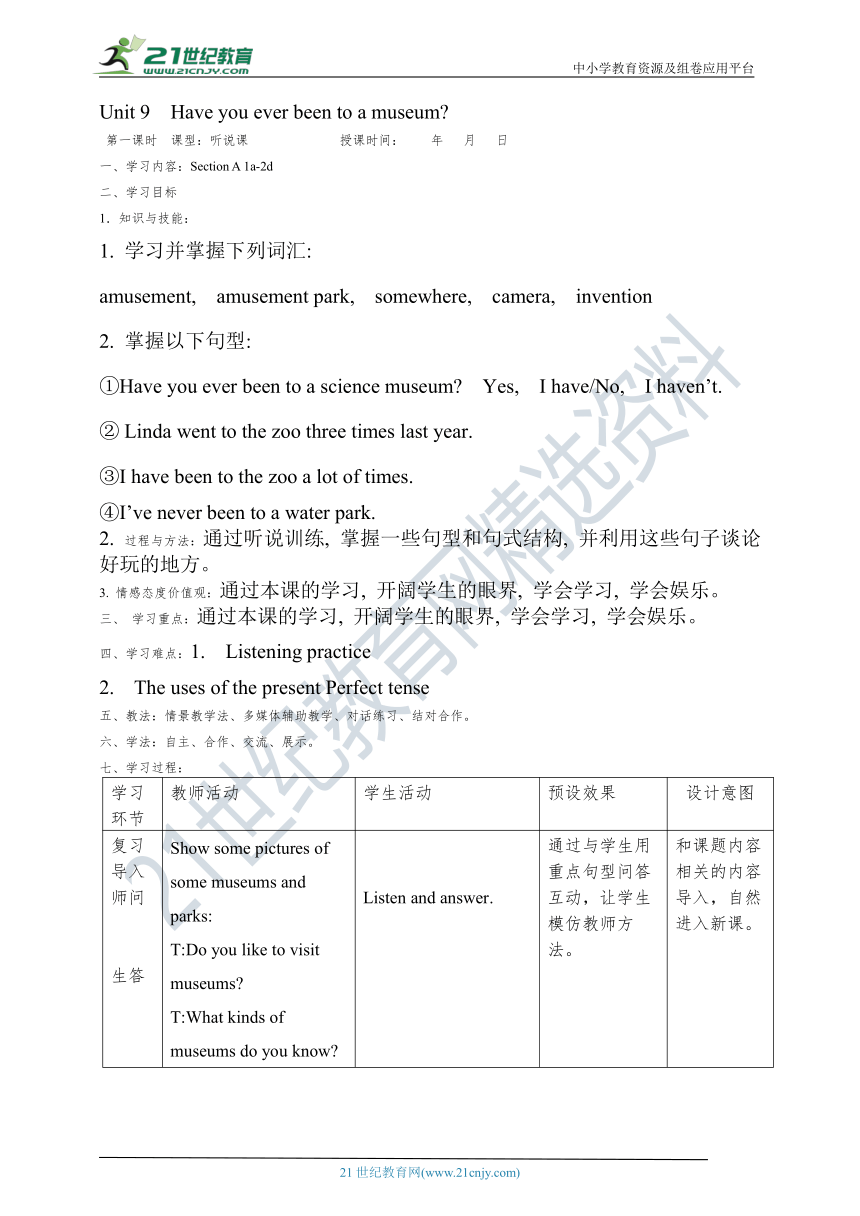 | |
| 格式 | zip | ||
| 文件大小 | 1.3MB | ||
| 资源类型 | 试卷 | ||
| 版本资源 | 人教新目标(Go for it)版 | ||
| 科目 | 英语 | ||
| 更新时间 | 2021-08-21 07:21:17 | ||
图片预览

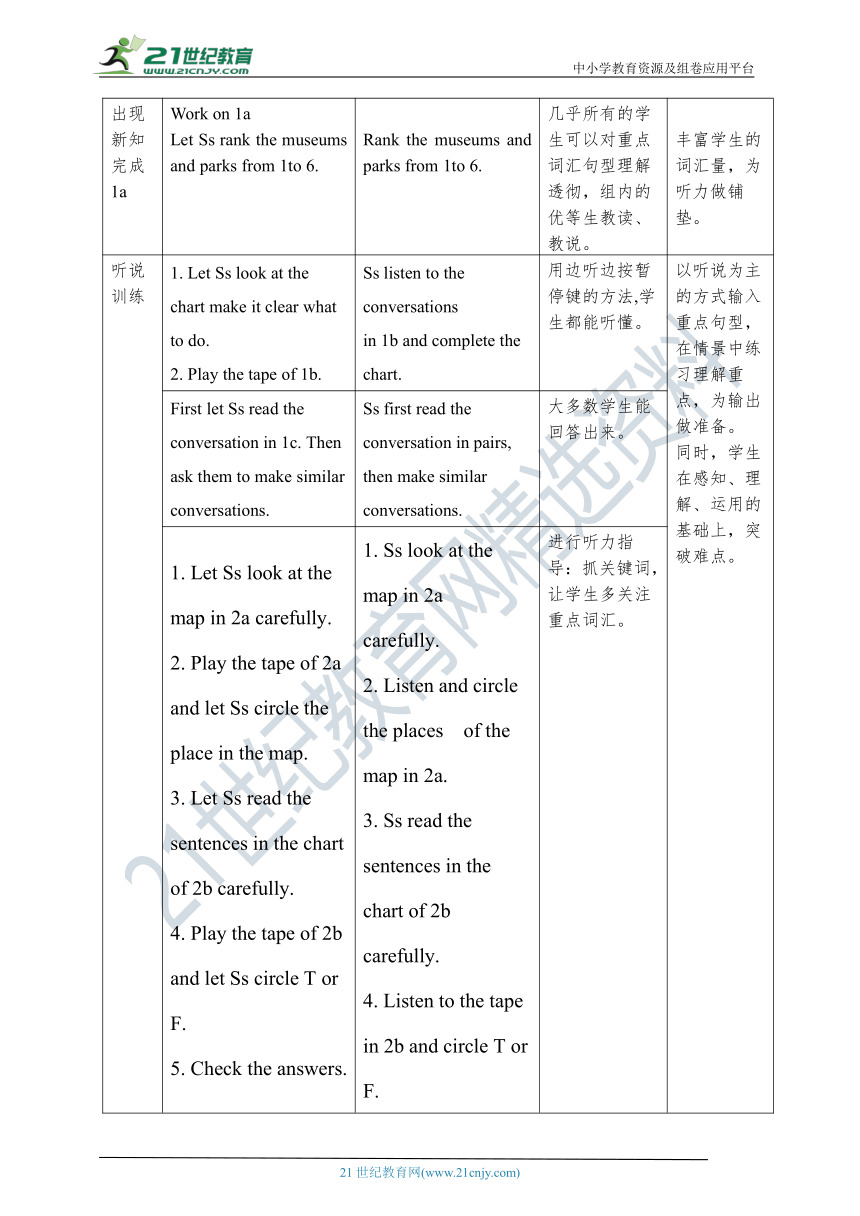
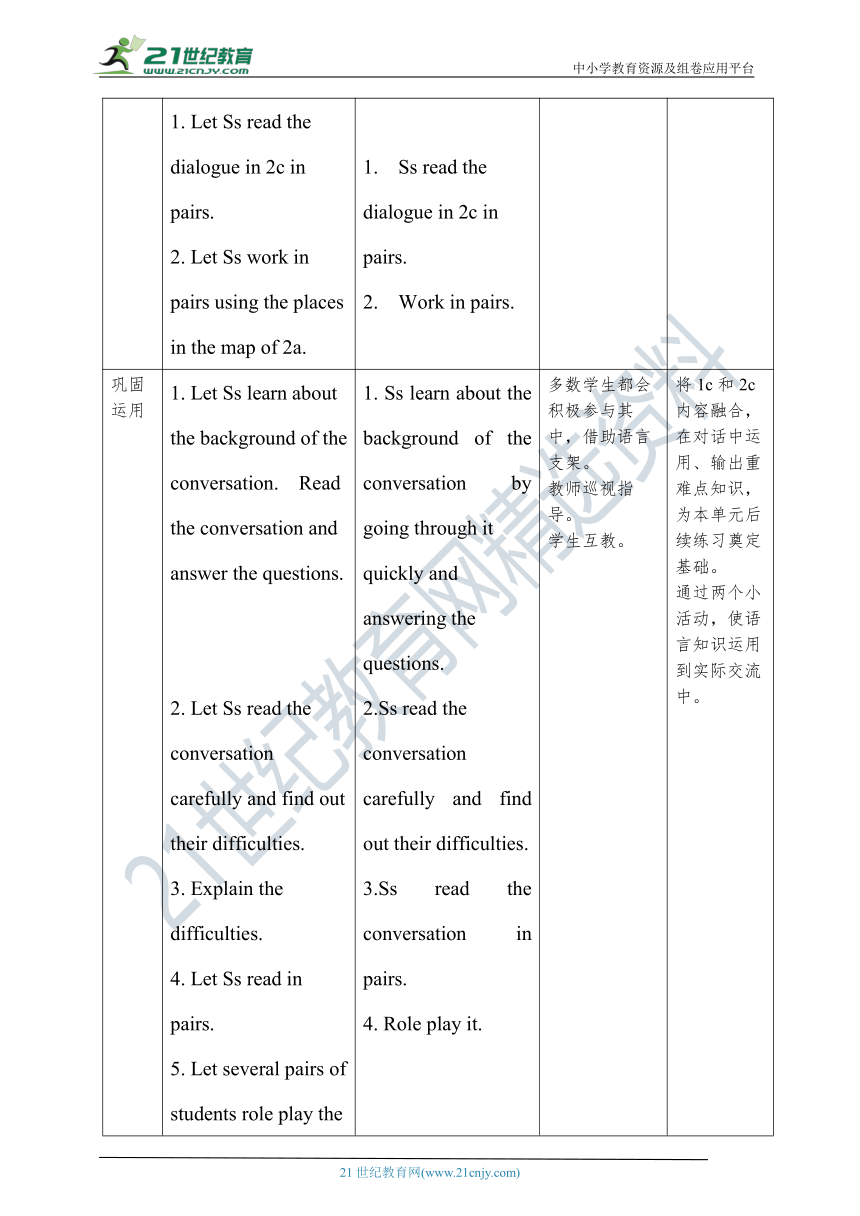
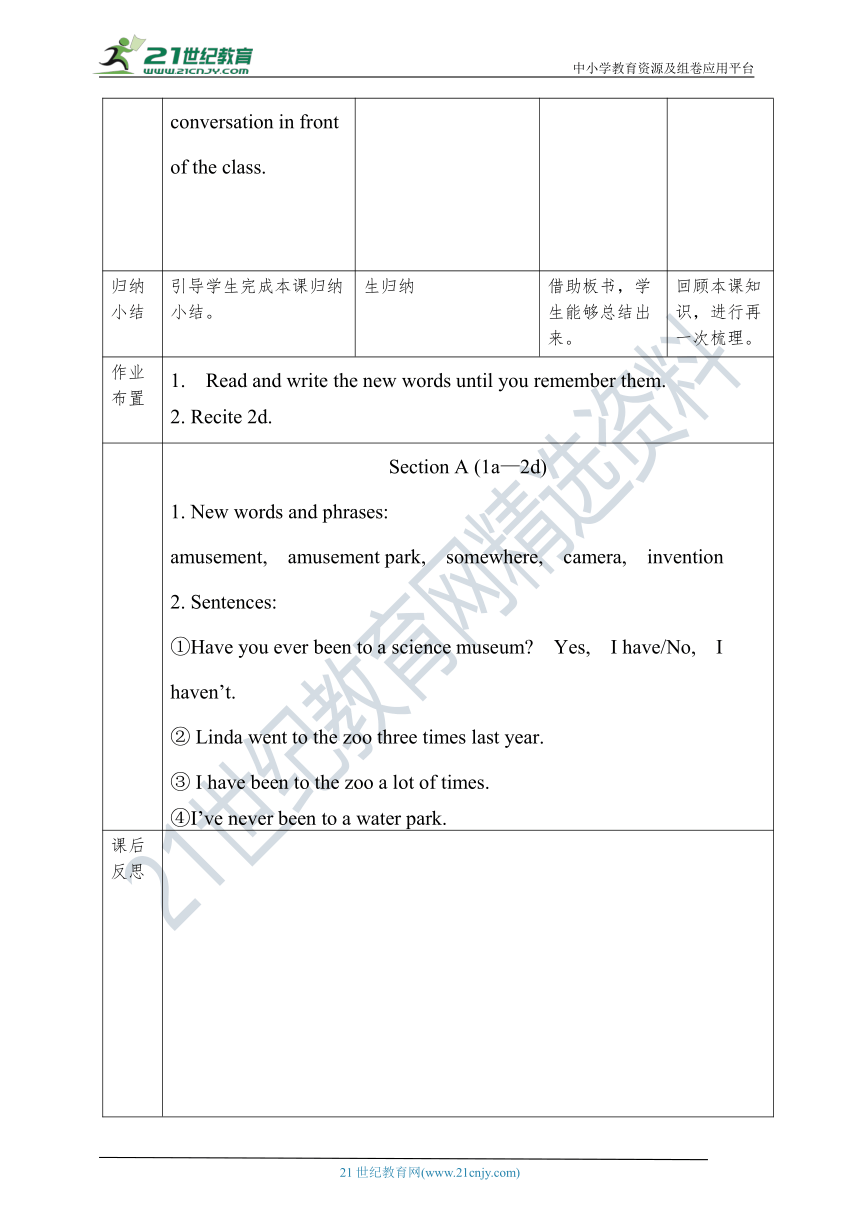
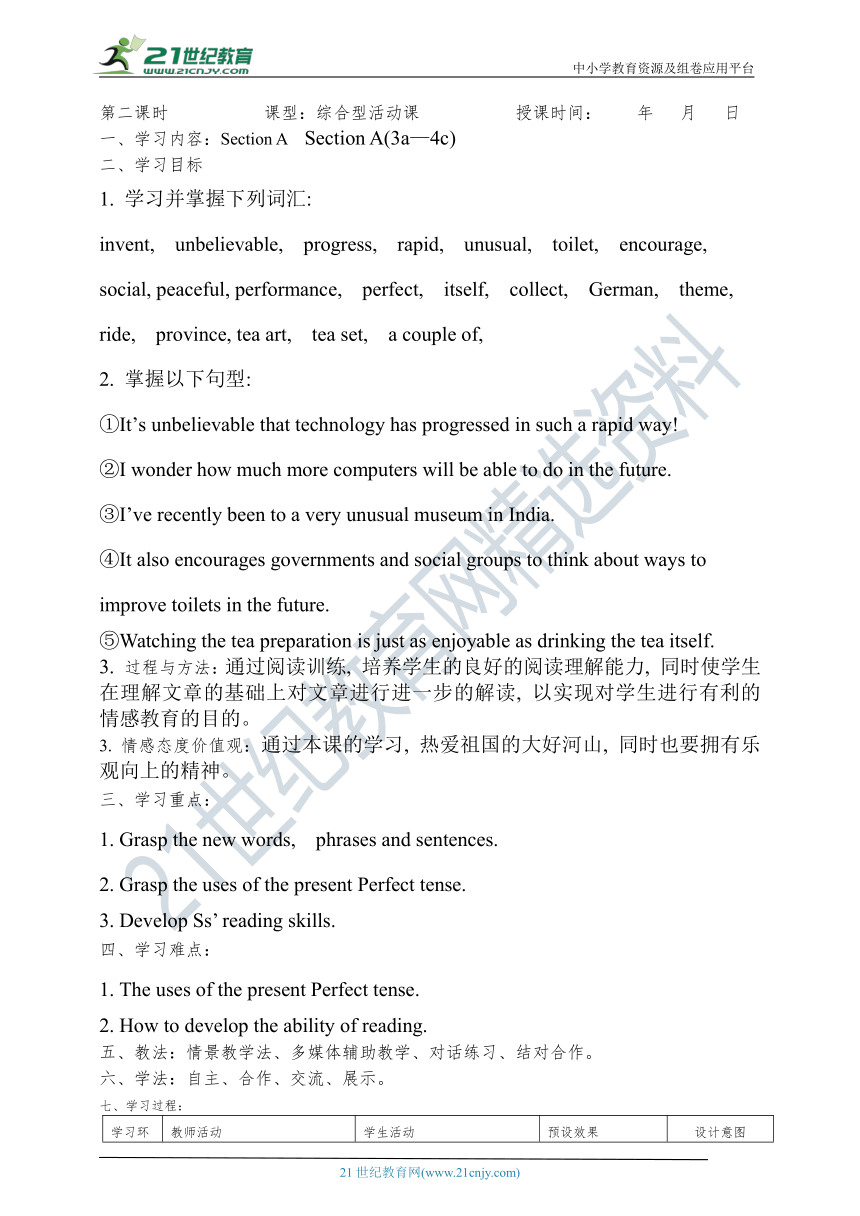
文档简介
中小学教育资源及组卷应用平台
Unit
9 Have
you
ever
been
to
a
museum?
第一课时
课型:听说课
授课时间:
年
月
日
一、学习内容:Section
A
1a-2d
二、学习目标
1.知识与技能:
1.
学习并掌握下列词汇:
amusement,
amusement
park,
somewhere,
camera,
invention
2.
掌握以下句型:
①Have
you
ever
been
to
a
science
museum?
Yes,
I
have/No,
I
haven’t.
②
Linda
went
to
the
zoo
three
times
last
year.
③I
have
been
to
the
zoo
a
lot
of
times.
④I’ve
never
been
to
a
water
park.
过程与方法:通过听说训练,
掌握一些句型和句式结构,
并利用这些句子谈论好玩的地方。
3.
情感态度价值观:通过本课的学习,
开阔学生的眼界,
学会学习,
学会娱乐。
三、
学习重点:通过本课的学习,
开阔学生的眼界,
学会学习,
学会娱乐。
四、学习难点:1.
Listening
practice
2.
The
uses
of
the
present
Perfect
tense
五、教法:情景教学法、多媒体辅助教学、对话练习、结对合作。
六、学法:自主、合作、交流、展示。
七、学习过程:
学习环节
教师活动
学生活动
预设效果
设计意图
复习导入师问生答
Show
some
pictures
of
some
museums
and
parks:
T:Do
you
like
to
visit
museums?
T:What
kinds
of
museums
do
you
know?
Listen
and
answer.
通过与学生用重点句型问答互动,让学生模仿教师方法。
和课题内容相关的内容导入,自然进入新课。
出现新知完成1a
Work
on
1aLet
Ss
rank
the
museums
and
parks
from
1to
6.
Rank
the
museums
and
parks
from
1to
6.
几乎所有的学生可以对重点词汇句型理解透彻,组内的优等生教读、教说。
丰富学生的词汇量,为听力做铺垫。
听说训练
1.
Let
Ss
look
at
the
chart
make
it
clear
what
to
do.
2.
Play
the
tape
of
1b.
Ss
listen
to
the
conversations
in
1b
and
complete
the
chart.
用边听边按暂停键的方法,学生都能听懂。
以听说为主的方式输入重点句型,在情景中练习理解重点,为输出做准备。同时,学生在感知、理解、运用的基础上,突破难点。
First
let
Ss
read
the
conversation
in
1c.
Then
ask
them
to
make
similar
conversations.
Ss
first
read
the
conversation
in
pairs,
then
make
similar
conversations.
大多数学生能回答出来。
1.
Let
Ss
look
at
the
map
in
2a
carefully.
2.
Play
the
tape
of
2a
and
let
Ss
circle
the
place
in
the
map.
3.
Let
Ss
read
the
sentences
in
the
chart
of
2b
carefully.
4.
Play
the
tape
of
2b
and
let
Ss
circle
T
or
F.
5.
Check
the
answers.
1.
Ss
look
at
the
map
in
2a carefully.
2.
Listen
and
circle
the
places of
the
map
in
2a.
3.
Ss
read
the
sentences
in
the
chart
of
2b
carefully.
4.
Listen
to
the
tape
in
2b
and
circle
T
or
F.
进行听力指导:抓关键词,让学生多关注重点词汇。
1.
Let
Ss
read
the
dialogue
in
2c
in
pairs.
2.
Let
Ss
work
in
pairs
using
the
places
in
the
map
of
2a.
1.
Ss
read
the
dialogue
in
2c
in
pairs.
2.
Work
in
pairs.
巩固运用
1.
Let
Ss
learn
about
the
background
of
the
conversation.
Read
the
conversation
and
answer
the
questions.
2.
Let
Ss
read
the
conversation
carefully
and
find
out
their
difficulties.
3.
Explain
the
difficulties.
4.
Let
Ss
read
in
pairs.
5.
Let
several
pairs
of
students
role
play
the
conversation
in
front
of
the
class.
1.
Ss
learn
about
the
background
of
the
conversation
by
going
through
it
quickly
and
answering
the
questions.2.Ss
read
the
conversation
carefully
and
find
out
their
difficulties.3.Ss
read
the
conversation
in
pairs.4.
Role
play
it.
多数学生都会积极参与其中,借助语言支架。教师巡视指导。学生互教。
将1c和2c内容融合,在对话中运用、输出重难点知识,为本单元后续练习奠定基础。通过两个小活动,使语言知识运用到实际交流中。
归纳小结
引导学生完成本课归纳小结。
生归纳
借助板书,学生能够总结出来。
回顾本课知识,进行再一次梳理。
作业布置
1.
Read
and
write
the
new
words
until
you
remember
them.
2.
Recite
2d.
Section
A
(1a—2d)1.
New
words
and
phrases:
amusement,
amusement
park,
somewhere,
camera,
invention2.
Sentences:
①Have
you
ever
been
to
a
science
museum?
Yes,
I
have/No,
I
haven’t.
②
Linda
went
to
the
zoo
three
times
last
year.
③
I
have
been
to
the
zoo
a
lot
of
times.
④I’ve
never
been
to
a
water
park.
课后反思
第二课时
课型:综合型活动课
授课时间:
年
月
日
一、学习内容:Section
A
Section
A(3a—4c)
二、学习目标
1.
学习并掌握下列词汇:
invent,
unbelievable,
progress,
rapid,
unusual,
toilet,
encourage,
social,
peaceful,
performance,
perfect,
itself,
collect,
German,
theme,
ride,
province,
tea
art,
tea
set,
a
couple
of,
2.
掌握以下句型:
①It’s
unbelievable
that
technology
has
progressed
in
such
a
rapid
way!
②I
wonder
how
much
more
computers
will
be
able
to
do
in
the
future.
③I’ve
recently
been
to
a
very
unusual
museum
in
India.
④It
also
encourages
governments
and
social
groups
to
think
about
ways
to
improve
toilets
in
the
future.
⑤Watching
the
tea
preparation
is
just
as
enjoyable
as
drinking
the
tea
itself.
过程与方法:通过阅读训练,
培养学生的良好的阅读理解能力,
同时使学生在理解文章的基础上对文章进行进一步的解读,
以实现对学生进行有利的情感教育的目的。
3.
情感态度价值观:通过本课的学习,
热爱祖国的大好河山,
同时也要拥有乐观向上的精神。
三、学习重点:
1.
Grasp
the
new
words,
phrases
and
sentences.
2.
Grasp
the
uses
of
the
present
Perfect
tense.
3.
Develop
Ss’
reading
skills.
四、学习难点:
1.
The
uses
of
the
present
Perfect
tense.
2.
How
to
develop
the
ability
of
reading.
五、教法:情景教学法、多媒体辅助教学、对话练习、结对合作。
六、学法:自主、合作、交流、展示。
七、学习过程:
学习环节
教师活动
学生活动
预设效果
设计意图
3a
3b
Pre-readingLook
at
the
pictures
in
3a,
say
out
the
names
of
the
three
museums.
While-reading1.
速读
(Fast
Reading)Read
3a
quickly
and
find
the
answers
to
the
question
2
in
the
box
of
3aWhat
do
you
think
is
the
most
interesting
thing
about
each
museum?
2.
Careful
Reading
(3b)Read
the
passage
again,
and
answer
the
questions
of
3b.
3.
朗读
(Loud
Reading)(1)Read
after
the
tape.
(2)Read
the
passage
by
themselves,
and
then
give
some
of
them
show
time.
1.
Look
at
the
pictures
in
3a,
say
out
the
names
of
the
three
museums.
2.
Read
the
article
quickly
and
answer
the
question.
3.
Read
the
article
and
answer
the
questions
of
3b.
4.
Read
the
article
loudly
and
then
some
Ss
show
their
reading.
通过与学生用重点句型问答互动,让学生模仿教师谈论学习方法。
用紧扣本课时重点学习内容的话题导入,自然进入新课。
3c
Lead
Ss
think
about
the
words
underlined
and
finish
the
exercise
of
3c3c.
Which
of
the
underlined
words
in
the
passage
have
the
following
meanings?
make(something)
better—improvebecome
better—progresseduncommon—unusualquiet—peacefulmade—inventedquick—rapid
Finish
the
exercise
of
3c.
大部分的学生可以对重点词汇句型理解透彻,部分人可能会对重点词汇读不准确。组内的优等生教读、教说。
通过阅读分析文章,学生的阅读分析能力在这一环节得到提升;小结训练又及时地巩固强化了重要的知识点。。
GrammarFocus
1.
Let
Ss
read
the
sentences
in
grammar
focus
three
times.
2.
Let
Ss
sum
up
the
use
of“have
/has
been
to”.
have
been
to与have
gone
to
的区别
1.
Read
the
sentences
in
grammar
focus
three
times.
2.
Listen
carefully
and
take
notes.
have
(has)
been
to意为“曾经去过某地”,
表示现在已经不在那里了。可与just,
ever,
never等连用。have
(has)
gone
to意为“到某地去了”,
表示到了某地或正在去某地的途中。总之,
说话时该人不在现场,
一般不用第一、第二人称代词作句子的主语。
教读难点词汇。借助板书指导。
以阅读,练习为主的方式输入重点句型,在情景中练习理解重点,并辅以笔头练习,为输出做准备。同时,学生在感知、理解、运用的基础上,突破难点。在阅读练习中运用、输出重难点知识,检测重点单词句型的使用情况。
(4a,
4b&4c)
1.
Let
Ss
finish
the
exercises
of
4a,
4b.
2.
Let
them
check
their
answers
in
groups.
3.
Do
a
surveyLet
Ss
work
in
groups,
and
make
a
survey
according
to
the
chart
in
4c.
Then
show
the
result
of
the
survey:
S1
has
never
been
to
another
province
in
China.
S2
has
been
to.
.
.
.
1.
Put
the
correct
forms
of
the
verbs
in
the
blanks.
2.
Fill
in
the
blanks
with
the
correct
forms
of
the
verbs
in
brackets.
3.
Check
the
answers
in
groups.
4.
Work
in
groups.
5.
Some
Ss
say
out
the
result
of
the
survey.
学生问题不大,个别辅导。
总结归纳
引导学生完成本课归纳小结。
生归纳
借助板书,学生能够总结出来。
回顾本课知识,进行再一次梳理。
作业
1.
Recite
new
words,
phrases
and
sentences.
2.
Read
3a
over
and
over
again.
板书设计
Section
A
(3a—4c)1.
Words:
2.
Sentences:
3.
Grammar:
have
(has)
been
to可与just,
ever,
never等连用。have
(has)
gone
to
课后反思
第三课时
课型:听说课
授课时间:
年
月
日
一、学习内容:Section
B(1a—1d)
二、学习目标
1.知识与技能:
1.
学习并掌握下列词汇:
Terracotta,
Nest,
Palace.
2.
掌握以下句型:
①Have
you
been
to
the
Great
Wall?
②Have
you
been
to
the
Bird’s
Nest?
③Have
you
seen
the
Terracotta
Army?
④Have
you
tried
Chinese
food?
⑤Have
you
visited
the
Palace
Museum?
2.
过程与方法:结合旅游情境继续学习现在完成时,
并通过更加丰富的听力材料拓展出学生在参观游览时的细节。
3.
情感态度价值观:通过本课的学习,
互相交流曾经旅游过的地方,
增长知识,
开阔学生的视野,
热爱祖国壮丽河山。立志学习,
积极进取。
三、
学习重点:Talk
about
interesting
places.
四、学习难点:Listening
practice.
五、教法:情景教学法、多媒体辅助教学、对话练习、结对合作。
六、学法:自主、合作、交流、展示。
七、学习过程:
学习环节
教师活动
学生活动
预设效果
设计意图
师生问好
师生问好。?
认真倾听,并做相应互动。
学生能与老师交流。
亲近学生
导入呈现新课
1.
Guessing
gameLet
Ss
guess
what
the
interesting
places
are
by
watching
the
pictures
on
the
screen.
Then
come
to
1a.
2.
Let
Ss
look
at
the
pictures
and
learn
the
names,
then
match
the
pictures
with
the
names.
1.
Ss
watch
pictures
and
say
out
the
names
of
the
places.
2.
Ss
match
the
pictures
with
the
names.
通过与学生用重点句型问答互动,让学生模仿教师谈论各个科目的学习方法。
用紧扣本课时游戏导入,激发学生学习兴趣,自然进入新课。
听力训练
1.
Let
Ss
read
the
questions
in
the
box
in
1b
first.
2.
Play
the
tape
of
1b.
3.
Let
Ss
read
the
information
in
1c.
4.
Play
the
tape
of
1b
and
1c.
1.
Ss
read
he
questions
in
the
box
in
1b
first.
2.
Listen
and
check
the
questions
they
hear.
3.
Ss
read
the
information
in
1c.
4.
Listen
to
the
tape
in
1c
and
take
notes.
5.
Check
answers.
几乎所有的学生可以读会重点词汇,组内的优等生教读、教说。
把重点词汇融入重点句型中学习,在完成习题的过程中巩固运用重点句型,拓展句型内容。
口语输出
1d
Let
Ss
do
pair
work.
Ask
and
answer
in
pairs
about
the
places
they
have
ever
been
to.
Work
in
pairs.
部分学生对重点词汇发音不准。教读难点词汇。
以听说为主的方式输入重点句型,在情景中练习理解重点,为输出做准备。同时,学生在感知、理解、运用的基础上,突破难点。
师播放听力生听核对答案
Reuse
the
listening
material,
let
Ss
fill
the
blanks
with
the
suitable
words
and
phrases.
Ss
fill
the
blanks
with
the
suitable
words
and
phrases.
Complete
the
passage
according
to
the
listening
material.
Peter
has
been
in
China
for
two
weeks.
He
is
going
back
to
Australia
tomorrow.
He
has
seen
many
interesting
things
here.
He
went
to
the
Palace
Museum
last
week.
There
are
so
many
beautiful
treasures.
He
also
has
been
to
the
Great
Wall
and
the
Bird’s
Nest.
He
thinks
the
Terracotta
Army
in
Xi’an
is
very
fantastic.
He
loves
Chinese
food
very
much.
His
favorite
dish
is
Beijing
Duck.
用边听边按暂停键的方法,只要是小学学过英语的学生都能听懂。
归纳小结
Guide
the
students
to
summarize
how
to
talk
about
interesting
places.
Summarize
how
to
talk
about
interesting
places.
借助板书,学生能够总结出来。
回顾本课知识,进行再一次梳理。
作业
Write
a
short
passage
about
one
interesting
place.
板书设计
1.
New
words:
Terracotta,
Nest,
Palace.
2.
Sentences:
①Have
you
been
to
the
Great
Wall?
②Have
you
been
to
the
Bird’s
Nest?
③Have
you
seen
the
Terracotta
Army?
④
Have
you
tried
Chinese
food?
课后反思
第四课时
课型:综合型阅读课
授课时间:
年
月
日
一、学习内容:Section
B
2a-2e
二、学习目标
1.知识与技能:
(1)学习并掌握下列词汇:
thousand,
safe,
simply,
fear,
whether,
Indian,
Japanese,
fox,
equator,
whenever,
spring,
mostly,
location,
thousands
of,
on
the
one
hand.
.
.
on
the
other
hand,
all
year
round
(2)掌握以下句型:
①Have
you
ever
been
to
Singapore?
②This
is
because
the
island
is
so
close
to
the
equator.
③Have
you
ever
tried
Chinese
food
outside
of
China?
④
You
won’t
have
any
problem
getting
rice,
noodles,
or
dumplings.
⑤This
is
the
best
time
to
watch
them.
⑥One
great
thing
about
Singapore
is
that
the
temperature
is
almost
the
same
all
year
round.
过程与方法:通过阅读训练,
从语言,
食物,
动物园,
天气四个方面了解新加坡,
并学会表述去新加坡旅游的理由。同时练习学生的写作能力。
3.
情感态度价值观:通过本课的学习,
互相交流曾经旅游过的地方,
增长知识,
开阔学生的视野,
热爱祖国壮丽河山。立志学习,
积极进取。
三、
学习重点:1.
Grasp
the
new
words,
phrases
and
sentences
2.
Consolidate
the
uses
of
the
Present
Perfect
Tense.
3.
Develop
Ss’
reading
and
writing
skills.
四、学习难点:1.
The
uses
of
the
Present
Perfect
Tense.
2.
How
to
develop
the
ability
of
reading
and
writing.
五、教法:情景教学法、多媒体辅助教学、阅读训练、结对合作。
六、学法:自主、合作、交流、展示。
七、教学流程:
学习环节
教师活动
学生活动
预设效果
设计意图
导入
Check
Ss’
preparations.
Correct
Ss’
pronunciation.
Free
Talk
.
Ss
read
the
words:
thousand,
thousands
of,
safe,
simply,
fear,
whether,
Indian,
Japanese,
fox,
all
year
round,
equator,
whenever,
spring,
mostly,
location,
Read
the
words
after
the
teacher.
通过与学生用重点句型问答互动,让学生几乎能与老师用旧知与老师交流。
以和2a相关的话题导入新课,设置悬念,引起学生的好奇心,引出本节课的学习内容。
读前活动
Work
on
2a.
4Play
a
video
about
the
country
of
Singapore,
then
ask:
Do
you
think
Singapore
is
a
beautiful
country?
Why?
Ss
watch
a
video
and
answer
the
questions.
学生几乎所有人都能将姓名找出来并准确配对。
以扫读训练方式训练学生快速阅读并提取有效信息的能力。通过分层阅读,
让学生对整篇短文有一个整体的理解,
再通过分层阅读,降低难度,增强学生自信,
找出重要的语言点和难点,
培养学生阅读技能。培训学生理解文章的能力,巩固阅读效果归纳语言知识点,加深理解记忆,提升扫除阅读障碍的能力
2b2c
1.
Fast
readingLet
Ss
read
the
passage
quickly
and
match:
Para
1 zooPara
2 language,
location,
populationPara
3 temperaturePara
4 food2.
Careful
readingRead
carefully,
discuss
with
your
classmates
and
finish
the
5
tasks.
(1)Read
Paragraph
1,
and
finish
the
chart.
locationlanguagepopulation(2)Read
Paragraph
2,
then
write
True
or
False①Maybe
you
fear
that
you
won’t
be
able
to
find
anything
to
eat
in
a
foreign
country.
T②In
Singapore,
you
can’t
find
Chinese
food.
F③You
won’t
have
any
problem
finding
rice,
noodles,
or
dumplings.
T④Singapore
isn’t
an
excellent
place
to
try
new
food.
F⑤Whether
you
like
India
food,
western
food,
or
Korea
food,
you
will
find
it
all
in
Singapore.
F(3)Read
Paragraph
3,
then
fill
in
the
blanks.
①Singapore
has
a
special
zoo
called
.
?②A
lot
of
animals
at
night,
so
this
is
to
watch
them.
?③At
the
zoo,
you
can
watch
lions,
tigers,
and
foxes
in
a
than
.
?(4)Read
Paragraph
4,
and
answer
the
questions.
①How
is
the
weather
in
Singapore?
And
why?
②
Can
we
go
to
Singapore
in
Winter?
(5)
Read
the
whole
passage
and
finish
2c.
3.
Loud
Reading
Let
Ss
read
after
the
tape
and
find
the
difficulties.
1.
Read
the
passage
of
2b
quickly
and
match.
2.
Read
Paragraph
1,
and
complete
the
chart.
3.
Read
Paragraph
2,
then
write
True
or
False
4.
Ss
read
Paragraph
3,
then
fill
in
the
blanks.
5.
Ss
read
Paragraph
4,
and
answer
the
questions.
6.
Ss
read
the
whole
passage
and
finish
2c.
读后活动
1.
Let
Ss
complete
the
conversation
according
to
the
information
from
the
passage
of
2a.
2.
Let
Ss
practice
the
conversation
in
pairs.
1.
Ss
complete
the
conversation
according
to
the
information
from
the
passage
of
2a.
2.
Practice
the
conversation
in
pairs.
语言点知识归纳
1.
three
quarters
四分之三(1)英语中分数表达法为“分子+分母”结构,
分子用基数词,
分母用序数词;
分子大于1时,
分母的序数词用复数形式,
常用“分数+of+名词”表示“……中的几分之几”(2)当分母是“四”时,
常用a
quarter
表示四分之一;
three
quarters表示四分之三。(3)分子和分母之间既可以加连字符“—”,
也可以不加。2.
whether
conj.
是否(1)whether引导让步状语从句,
意为“不管……(还是)”,
在表示选择时,
用whether.
.
.
or.
.
.
;
(2)whether引导宾语从句,
意为“是否”,
在口语中whether与if可互换,
whether可与or
not直接连用,
但if不能(能/不能)。3.
whenever引导的让步状语从句,
whenever意为“无论何时”,
相当于no
matter
when。【拓展延伸】由疑问词
+ever构成的复合连词还有:
whoever
=
no
matter
who无论谁whatever
=
no
matter
what无论什么wherever
=
no
matter
where无论哪儿however
=
no
matter
how无论怎样
Listen
to
the
teacher
carefully
and
take
notes.
作业
记忆本课时重点语言知识点
板书设计
重点词汇whoever
=
no
matter
who无论谁whatever
=
no
matter
what无论什么wherever
=
no
matter
where无论哪儿however
=
no
matter
how无论怎样
课后反思
第五课时
课型:综合活动课
授课时间:
年
月
日
一、学习内容:Section
B
3a-Self
Check
3
二、学习目标
1.知识与技能:
1)会从以下几个方面介绍自己家乡:面积、位置、人口、气候、历史、你去过的地方和吃过的东西。
2)复习本单元目标句型。
2.
过程与方法:通过情景创设,体验学习,以写作训练,习题训练等方式让学生在轻松的氛围中复习单元目标句型和介绍自己的家乡。
3.
情感态度价值观:培养学生热爱自己的家乡。
三、
学习重点:1)会从以下几个方面介绍自己家乡:面积、位置、人口、气候、历史、你去过的地方和吃过的东西。
2)复习本单元目标句型。
四、学习难点:会从以下几个方面介绍自己家乡:面积、位置、人口、气候、历史、你去过的地方和吃过的东西。
五、教法:情景教学法、多媒体辅助教学、写作训练、结对合作。
六、学法:自主、合作、交流、展示。
学习环节
教师活动
学生活动
预设效果
设计意图
师生问好
师生问好。?
认真倾听,并做相应互动。
学生能与老师交流。
亲近学生
3a
3b
1.
3a
Let
Ss
make
a
list
of
facts
about
their
hometown
or
a
place
they
have
been
to.
Think
about
these
topics.
2.
Let
Ss
write
an
artice
with
the
help
of
3a
and
the
information
of
3b.
1.
Ss
fill
in
the
chart.
2.Write
down
their
composition
in
their
exercise-books.
在教师由浅入深的引导中,学生都能写出一些句子。借助词汇表,教师的指导完成。
以写作训练方式训练学生由简到难,逐步进入文本写作训练,从局部到整体,层层推进。同时,学生在练习、巩固、写作的基础上,突破重难点。
Self
Check1、2
Let
Ss
finish
the
exercises
1-2
of
Self
Check
1.
Think
about
the
things
and
write
an
answer
for
each
one.
2.
Complete
the
conversation.
3.
Share
the
answers.
学生有一定的困难,可以小组合作
完成练习,在对话情境中进一步运用巩固目标语言。
Self
Check3
Guide
the
students
to
summarize
the
useful
expressions
and
how
to
use
the
Present
Perfect
Tense.
Summarize
the
useful
expressions
and
how
to
use
the
Present
Perfect
Tense.
学生几乎所有人都能写出一些
培训学生梳理单元知识脉络的能力,形成自己的学习方法。
作业
1.
Recite
new
words
and
phrases.
2.
Write
a
short
passage
about
your
hometown
or
a
place
you
have
been
to.
板书设计
Section
B
(2a—Self
Check)1.
Writing2.Words
and
phrases:
2.
Sentences:
课后反思
21世纪教育网
www.21cnjy.com
精品试卷·第
2
页
(共
2
页)
HYPERLINK
"http://21世纪教育网(www.21cnjy.com)
"
21世纪教育网(www.21cnjy.com)
Unit
9 Have
you
ever
been
to
a
museum?
第一课时
课型:听说课
授课时间:
年
月
日
一、学习内容:Section
A
1a-2d
二、学习目标
1.知识与技能:
1.
学习并掌握下列词汇:
amusement,
amusement
park,
somewhere,
camera,
invention
2.
掌握以下句型:
①Have
you
ever
been
to
a
science
museum?
Yes,
I
have/No,
I
haven’t.
②
Linda
went
to
the
zoo
three
times
last
year.
③I
have
been
to
the
zoo
a
lot
of
times.
④I’ve
never
been
to
a
water
park.
过程与方法:通过听说训练,
掌握一些句型和句式结构,
并利用这些句子谈论好玩的地方。
3.
情感态度价值观:通过本课的学习,
开阔学生的眼界,
学会学习,
学会娱乐。
三、
学习重点:通过本课的学习,
开阔学生的眼界,
学会学习,
学会娱乐。
四、学习难点:1.
Listening
practice
2.
The
uses
of
the
present
Perfect
tense
五、教法:情景教学法、多媒体辅助教学、对话练习、结对合作。
六、学法:自主、合作、交流、展示。
七、学习过程:
学习环节
教师活动
学生活动
预设效果
设计意图
复习导入师问生答
Show
some
pictures
of
some
museums
and
parks:
T:Do
you
like
to
visit
museums?
T:What
kinds
of
museums
do
you
know?
Listen
and
answer.
通过与学生用重点句型问答互动,让学生模仿教师方法。
和课题内容相关的内容导入,自然进入新课。
出现新知完成1a
Work
on
1aLet
Ss
rank
the
museums
and
parks
from
1to
6.
Rank
the
museums
and
parks
from
1to
6.
几乎所有的学生可以对重点词汇句型理解透彻,组内的优等生教读、教说。
丰富学生的词汇量,为听力做铺垫。
听说训练
1.
Let
Ss
look
at
the
chart
make
it
clear
what
to
do.
2.
Play
the
tape
of
1b.
Ss
listen
to
the
conversations
in
1b
and
complete
the
chart.
用边听边按暂停键的方法,学生都能听懂。
以听说为主的方式输入重点句型,在情景中练习理解重点,为输出做准备。同时,学生在感知、理解、运用的基础上,突破难点。
First
let
Ss
read
the
conversation
in
1c.
Then
ask
them
to
make
similar
conversations.
Ss
first
read
the
conversation
in
pairs,
then
make
similar
conversations.
大多数学生能回答出来。
1.
Let
Ss
look
at
the
map
in
2a
carefully.
2.
Play
the
tape
of
2a
and
let
Ss
circle
the
place
in
the
map.
3.
Let
Ss
read
the
sentences
in
the
chart
of
2b
carefully.
4.
Play
the
tape
of
2b
and
let
Ss
circle
T
or
F.
5.
Check
the
answers.
1.
Ss
look
at
the
map
in
2a carefully.
2.
Listen
and
circle
the
places of
the
map
in
2a.
3.
Ss
read
the
sentences
in
the
chart
of
2b
carefully.
4.
Listen
to
the
tape
in
2b
and
circle
T
or
F.
进行听力指导:抓关键词,让学生多关注重点词汇。
1.
Let
Ss
read
the
dialogue
in
2c
in
pairs.
2.
Let
Ss
work
in
pairs
using
the
places
in
the
map
of
2a.
1.
Ss
read
the
dialogue
in
2c
in
pairs.
2.
Work
in
pairs.
巩固运用
1.
Let
Ss
learn
about
the
background
of
the
conversation.
Read
the
conversation
and
answer
the
questions.
2.
Let
Ss
read
the
conversation
carefully
and
find
out
their
difficulties.
3.
Explain
the
difficulties.
4.
Let
Ss
read
in
pairs.
5.
Let
several
pairs
of
students
role
play
the
conversation
in
front
of
the
class.
1.
Ss
learn
about
the
background
of
the
conversation
by
going
through
it
quickly
and
answering
the
questions.2.Ss
read
the
conversation
carefully
and
find
out
their
difficulties.3.Ss
read
the
conversation
in
pairs.4.
Role
play
it.
多数学生都会积极参与其中,借助语言支架。教师巡视指导。学生互教。
将1c和2c内容融合,在对话中运用、输出重难点知识,为本单元后续练习奠定基础。通过两个小活动,使语言知识运用到实际交流中。
归纳小结
引导学生完成本课归纳小结。
生归纳
借助板书,学生能够总结出来。
回顾本课知识,进行再一次梳理。
作业布置
1.
Read
and
write
the
new
words
until
you
remember
them.
2.
Recite
2d.
Section
A
(1a—2d)1.
New
words
and
phrases:
amusement,
amusement
park,
somewhere,
camera,
invention2.
Sentences:
①Have
you
ever
been
to
a
science
museum?
Yes,
I
have/No,
I
haven’t.
②
Linda
went
to
the
zoo
three
times
last
year.
③
I
have
been
to
the
zoo
a
lot
of
times.
④I’ve
never
been
to
a
water
park.
课后反思
第二课时
课型:综合型活动课
授课时间:
年
月
日
一、学习内容:Section
A
Section
A(3a—4c)
二、学习目标
1.
学习并掌握下列词汇:
invent,
unbelievable,
progress,
rapid,
unusual,
toilet,
encourage,
social,
peaceful,
performance,
perfect,
itself,
collect,
German,
theme,
ride,
province,
tea
art,
tea
set,
a
couple
of,
2.
掌握以下句型:
①It’s
unbelievable
that
technology
has
progressed
in
such
a
rapid
way!
②I
wonder
how
much
more
computers
will
be
able
to
do
in
the
future.
③I’ve
recently
been
to
a
very
unusual
museum
in
India.
④It
also
encourages
governments
and
social
groups
to
think
about
ways
to
improve
toilets
in
the
future.
⑤Watching
the
tea
preparation
is
just
as
enjoyable
as
drinking
the
tea
itself.
过程与方法:通过阅读训练,
培养学生的良好的阅读理解能力,
同时使学生在理解文章的基础上对文章进行进一步的解读,
以实现对学生进行有利的情感教育的目的。
3.
情感态度价值观:通过本课的学习,
热爱祖国的大好河山,
同时也要拥有乐观向上的精神。
三、学习重点:
1.
Grasp
the
new
words,
phrases
and
sentences.
2.
Grasp
the
uses
of
the
present
Perfect
tense.
3.
Develop
Ss’
reading
skills.
四、学习难点:
1.
The
uses
of
the
present
Perfect
tense.
2.
How
to
develop
the
ability
of
reading.
五、教法:情景教学法、多媒体辅助教学、对话练习、结对合作。
六、学法:自主、合作、交流、展示。
七、学习过程:
学习环节
教师活动
学生活动
预设效果
设计意图
3a
3b
Pre-readingLook
at
the
pictures
in
3a,
say
out
the
names
of
the
three
museums.
While-reading1.
速读
(Fast
Reading)Read
3a
quickly
and
find
the
answers
to
the
question
2
in
the
box
of
3aWhat
do
you
think
is
the
most
interesting
thing
about
each
museum?
2.
Careful
Reading
(3b)Read
the
passage
again,
and
answer
the
questions
of
3b.
3.
朗读
(Loud
Reading)(1)Read
after
the
tape.
(2)Read
the
passage
by
themselves,
and
then
give
some
of
them
show
time.
1.
Look
at
the
pictures
in
3a,
say
out
the
names
of
the
three
museums.
2.
Read
the
article
quickly
and
answer
the
question.
3.
Read
the
article
and
answer
the
questions
of
3b.
4.
Read
the
article
loudly
and
then
some
Ss
show
their
reading.
通过与学生用重点句型问答互动,让学生模仿教师谈论学习方法。
用紧扣本课时重点学习内容的话题导入,自然进入新课。
3c
Lead
Ss
think
about
the
words
underlined
and
finish
the
exercise
of
3c3c.
Which
of
the
underlined
words
in
the
passage
have
the
following
meanings?
make(something)
better—improvebecome
better—progresseduncommon—unusualquiet—peacefulmade—inventedquick—rapid
Finish
the
exercise
of
3c.
大部分的学生可以对重点词汇句型理解透彻,部分人可能会对重点词汇读不准确。组内的优等生教读、教说。
通过阅读分析文章,学生的阅读分析能力在这一环节得到提升;小结训练又及时地巩固强化了重要的知识点。。
GrammarFocus
1.
Let
Ss
read
the
sentences
in
grammar
focus
three
times.
2.
Let
Ss
sum
up
the
use
of“have
/has
been
to”.
have
been
to与have
gone
to
的区别
1.
Read
the
sentences
in
grammar
focus
three
times.
2.
Listen
carefully
and
take
notes.
have
(has)
been
to意为“曾经去过某地”,
表示现在已经不在那里了。可与just,
ever,
never等连用。have
(has)
gone
to意为“到某地去了”,
表示到了某地或正在去某地的途中。总之,
说话时该人不在现场,
一般不用第一、第二人称代词作句子的主语。
教读难点词汇。借助板书指导。
以阅读,练习为主的方式输入重点句型,在情景中练习理解重点,并辅以笔头练习,为输出做准备。同时,学生在感知、理解、运用的基础上,突破难点。在阅读练习中运用、输出重难点知识,检测重点单词句型的使用情况。
(4a,
4b&4c)
1.
Let
Ss
finish
the
exercises
of
4a,
4b.
2.
Let
them
check
their
answers
in
groups.
3.
Do
a
surveyLet
Ss
work
in
groups,
and
make
a
survey
according
to
the
chart
in
4c.
Then
show
the
result
of
the
survey:
S1
has
never
been
to
another
province
in
China.
S2
has
been
to.
.
.
.
1.
Put
the
correct
forms
of
the
verbs
in
the
blanks.
2.
Fill
in
the
blanks
with
the
correct
forms
of
the
verbs
in
brackets.
3.
Check
the
answers
in
groups.
4.
Work
in
groups.
5.
Some
Ss
say
out
the
result
of
the
survey.
学生问题不大,个别辅导。
总结归纳
引导学生完成本课归纳小结。
生归纳
借助板书,学生能够总结出来。
回顾本课知识,进行再一次梳理。
作业
1.
Recite
new
words,
phrases
and
sentences.
2.
Read
3a
over
and
over
again.
板书设计
Section
A
(3a—4c)1.
Words:
2.
Sentences:
3.
Grammar:
have
(has)
been
to可与just,
ever,
never等连用。have
(has)
gone
to
课后反思
第三课时
课型:听说课
授课时间:
年
月
日
一、学习内容:Section
B(1a—1d)
二、学习目标
1.知识与技能:
1.
学习并掌握下列词汇:
Terracotta,
Nest,
Palace.
2.
掌握以下句型:
①Have
you
been
to
the
Great
Wall?
②Have
you
been
to
the
Bird’s
Nest?
③Have
you
seen
the
Terracotta
Army?
④Have
you
tried
Chinese
food?
⑤Have
you
visited
the
Palace
Museum?
2.
过程与方法:结合旅游情境继续学习现在完成时,
并通过更加丰富的听力材料拓展出学生在参观游览时的细节。
3.
情感态度价值观:通过本课的学习,
互相交流曾经旅游过的地方,
增长知识,
开阔学生的视野,
热爱祖国壮丽河山。立志学习,
积极进取。
三、
学习重点:Talk
about
interesting
places.
四、学习难点:Listening
practice.
五、教法:情景教学法、多媒体辅助教学、对话练习、结对合作。
六、学法:自主、合作、交流、展示。
七、学习过程:
学习环节
教师活动
学生活动
预设效果
设计意图
师生问好
师生问好。?
认真倾听,并做相应互动。
学生能与老师交流。
亲近学生
导入呈现新课
1.
Guessing
gameLet
Ss
guess
what
the
interesting
places
are
by
watching
the
pictures
on
the
screen.
Then
come
to
1a.
2.
Let
Ss
look
at
the
pictures
and
learn
the
names,
then
match
the
pictures
with
the
names.
1.
Ss
watch
pictures
and
say
out
the
names
of
the
places.
2.
Ss
match
the
pictures
with
the
names.
通过与学生用重点句型问答互动,让学生模仿教师谈论各个科目的学习方法。
用紧扣本课时游戏导入,激发学生学习兴趣,自然进入新课。
听力训练
1.
Let
Ss
read
the
questions
in
the
box
in
1b
first.
2.
Play
the
tape
of
1b.
3.
Let
Ss
read
the
information
in
1c.
4.
Play
the
tape
of
1b
and
1c.
1.
Ss
read
he
questions
in
the
box
in
1b
first.
2.
Listen
and
check
the
questions
they
hear.
3.
Ss
read
the
information
in
1c.
4.
Listen
to
the
tape
in
1c
and
take
notes.
5.
Check
answers.
几乎所有的学生可以读会重点词汇,组内的优等生教读、教说。
把重点词汇融入重点句型中学习,在完成习题的过程中巩固运用重点句型,拓展句型内容。
口语输出
1d
Let
Ss
do
pair
work.
Ask
and
answer
in
pairs
about
the
places
they
have
ever
been
to.
Work
in
pairs.
部分学生对重点词汇发音不准。教读难点词汇。
以听说为主的方式输入重点句型,在情景中练习理解重点,为输出做准备。同时,学生在感知、理解、运用的基础上,突破难点。
师播放听力生听核对答案
Reuse
the
listening
material,
let
Ss
fill
the
blanks
with
the
suitable
words
and
phrases.
Ss
fill
the
blanks
with
the
suitable
words
and
phrases.
Complete
the
passage
according
to
the
listening
material.
Peter
has
been
in
China
for
two
weeks.
He
is
going
back
to
Australia
tomorrow.
He
has
seen
many
interesting
things
here.
He
went
to
the
Palace
Museum
last
week.
There
are
so
many
beautiful
treasures.
He
also
has
been
to
the
Great
Wall
and
the
Bird’s
Nest.
He
thinks
the
Terracotta
Army
in
Xi’an
is
very
fantastic.
He
loves
Chinese
food
very
much.
His
favorite
dish
is
Beijing
Duck.
用边听边按暂停键的方法,只要是小学学过英语的学生都能听懂。
归纳小结
Guide
the
students
to
summarize
how
to
talk
about
interesting
places.
Summarize
how
to
talk
about
interesting
places.
借助板书,学生能够总结出来。
回顾本课知识,进行再一次梳理。
作业
Write
a
short
passage
about
one
interesting
place.
板书设计
1.
New
words:
Terracotta,
Nest,
Palace.
2.
Sentences:
①Have
you
been
to
the
Great
Wall?
②Have
you
been
to
the
Bird’s
Nest?
③Have
you
seen
the
Terracotta
Army?
④
Have
you
tried
Chinese
food?
课后反思
第四课时
课型:综合型阅读课
授课时间:
年
月
日
一、学习内容:Section
B
2a-2e
二、学习目标
1.知识与技能:
(1)学习并掌握下列词汇:
thousand,
safe,
simply,
fear,
whether,
Indian,
Japanese,
fox,
equator,
whenever,
spring,
mostly,
location,
thousands
of,
on
the
one
hand.
.
.
on
the
other
hand,
all
year
round
(2)掌握以下句型:
①Have
you
ever
been
to
Singapore?
②This
is
because
the
island
is
so
close
to
the
equator.
③Have
you
ever
tried
Chinese
food
outside
of
China?
④
You
won’t
have
any
problem
getting
rice,
noodles,
or
dumplings.
⑤This
is
the
best
time
to
watch
them.
⑥One
great
thing
about
Singapore
is
that
the
temperature
is
almost
the
same
all
year
round.
过程与方法:通过阅读训练,
从语言,
食物,
动物园,
天气四个方面了解新加坡,
并学会表述去新加坡旅游的理由。同时练习学生的写作能力。
3.
情感态度价值观:通过本课的学习,
互相交流曾经旅游过的地方,
增长知识,
开阔学生的视野,
热爱祖国壮丽河山。立志学习,
积极进取。
三、
学习重点:1.
Grasp
the
new
words,
phrases
and
sentences
2.
Consolidate
the
uses
of
the
Present
Perfect
Tense.
3.
Develop
Ss’
reading
and
writing
skills.
四、学习难点:1.
The
uses
of
the
Present
Perfect
Tense.
2.
How
to
develop
the
ability
of
reading
and
writing.
五、教法:情景教学法、多媒体辅助教学、阅读训练、结对合作。
六、学法:自主、合作、交流、展示。
七、教学流程:
学习环节
教师活动
学生活动
预设效果
设计意图
导入
Check
Ss’
preparations.
Correct
Ss’
pronunciation.
Free
Talk
.
Ss
read
the
words:
thousand,
thousands
of,
safe,
simply,
fear,
whether,
Indian,
Japanese,
fox,
all
year
round,
equator,
whenever,
spring,
mostly,
location,
Read
the
words
after
the
teacher.
通过与学生用重点句型问答互动,让学生几乎能与老师用旧知与老师交流。
以和2a相关的话题导入新课,设置悬念,引起学生的好奇心,引出本节课的学习内容。
读前活动
Work
on
2a.
4Play
a
video
about
the
country
of
Singapore,
then
ask:
Do
you
think
Singapore
is
a
beautiful
country?
Why?
Ss
watch
a
video
and
answer
the
questions.
学生几乎所有人都能将姓名找出来并准确配对。
以扫读训练方式训练学生快速阅读并提取有效信息的能力。通过分层阅读,
让学生对整篇短文有一个整体的理解,
再通过分层阅读,降低难度,增强学生自信,
找出重要的语言点和难点,
培养学生阅读技能。培训学生理解文章的能力,巩固阅读效果归纳语言知识点,加深理解记忆,提升扫除阅读障碍的能力
2b2c
1.
Fast
readingLet
Ss
read
the
passage
quickly
and
match:
Para
1 zooPara
2 language,
location,
populationPara
3 temperaturePara
4 food2.
Careful
readingRead
carefully,
discuss
with
your
classmates
and
finish
the
5
tasks.
(1)Read
Paragraph
1,
and
finish
the
chart.
locationlanguagepopulation(2)Read
Paragraph
2,
then
write
True
or
False①Maybe
you
fear
that
you
won’t
be
able
to
find
anything
to
eat
in
a
foreign
country.
T②In
Singapore,
you
can’t
find
Chinese
food.
F③You
won’t
have
any
problem
finding
rice,
noodles,
or
dumplings.
T④Singapore
isn’t
an
excellent
place
to
try
new
food.
F⑤Whether
you
like
India
food,
western
food,
or
Korea
food,
you
will
find
it
all
in
Singapore.
F(3)Read
Paragraph
3,
then
fill
in
the
blanks.
①Singapore
has
a
special
zoo
called
.
?②A
lot
of
animals
at
night,
so
this
is
to
watch
them.
?③At
the
zoo,
you
can
watch
lions,
tigers,
and
foxes
in
a
than
.
?(4)Read
Paragraph
4,
and
answer
the
questions.
①How
is
the
weather
in
Singapore?
And
why?
②
Can
we
go
to
Singapore
in
Winter?
(5)
Read
the
whole
passage
and
finish
2c.
3.
Loud
Reading
Let
Ss
read
after
the
tape
and
find
the
difficulties.
1.
Read
the
passage
of
2b
quickly
and
match.
2.
Read
Paragraph
1,
and
complete
the
chart.
3.
Read
Paragraph
2,
then
write
True
or
False
4.
Ss
read
Paragraph
3,
then
fill
in
the
blanks.
5.
Ss
read
Paragraph
4,
and
answer
the
questions.
6.
Ss
read
the
whole
passage
and
finish
2c.
读后活动
1.
Let
Ss
complete
the
conversation
according
to
the
information
from
the
passage
of
2a.
2.
Let
Ss
practice
the
conversation
in
pairs.
1.
Ss
complete
the
conversation
according
to
the
information
from
the
passage
of
2a.
2.
Practice
the
conversation
in
pairs.
语言点知识归纳
1.
three
quarters
四分之三(1)英语中分数表达法为“分子+分母”结构,
分子用基数词,
分母用序数词;
分子大于1时,
分母的序数词用复数形式,
常用“分数+of+名词”表示“……中的几分之几”(2)当分母是“四”时,
常用a
quarter
表示四分之一;
three
quarters表示四分之三。(3)分子和分母之间既可以加连字符“—”,
也可以不加。2.
whether
conj.
是否(1)whether引导让步状语从句,
意为“不管……(还是)”,
在表示选择时,
用whether.
.
.
or.
.
.
;
(2)whether引导宾语从句,
意为“是否”,
在口语中whether与if可互换,
whether可与or
not直接连用,
但if不能(能/不能)。3.
whenever引导的让步状语从句,
whenever意为“无论何时”,
相当于no
matter
when。【拓展延伸】由疑问词
+ever构成的复合连词还有:
whoever
=
no
matter
who无论谁whatever
=
no
matter
what无论什么wherever
=
no
matter
where无论哪儿however
=
no
matter
how无论怎样
Listen
to
the
teacher
carefully
and
take
notes.
作业
记忆本课时重点语言知识点
板书设计
重点词汇whoever
=
no
matter
who无论谁whatever
=
no
matter
what无论什么wherever
=
no
matter
where无论哪儿however
=
no
matter
how无论怎样
课后反思
第五课时
课型:综合活动课
授课时间:
年
月
日
一、学习内容:Section
B
3a-Self
Check
3
二、学习目标
1.知识与技能:
1)会从以下几个方面介绍自己家乡:面积、位置、人口、气候、历史、你去过的地方和吃过的东西。
2)复习本单元目标句型。
2.
过程与方法:通过情景创设,体验学习,以写作训练,习题训练等方式让学生在轻松的氛围中复习单元目标句型和介绍自己的家乡。
3.
情感态度价值观:培养学生热爱自己的家乡。
三、
学习重点:1)会从以下几个方面介绍自己家乡:面积、位置、人口、气候、历史、你去过的地方和吃过的东西。
2)复习本单元目标句型。
四、学习难点:会从以下几个方面介绍自己家乡:面积、位置、人口、气候、历史、你去过的地方和吃过的东西。
五、教法:情景教学法、多媒体辅助教学、写作训练、结对合作。
六、学法:自主、合作、交流、展示。
学习环节
教师活动
学生活动
预设效果
设计意图
师生问好
师生问好。?
认真倾听,并做相应互动。
学生能与老师交流。
亲近学生
3a
3b
1.
3a
Let
Ss
make
a
list
of
facts
about
their
hometown
or
a
place
they
have
been
to.
Think
about
these
topics.
2.
Let
Ss
write
an
artice
with
the
help
of
3a
and
the
information
of
3b.
1.
Ss
fill
in
the
chart.
2.Write
down
their
composition
in
their
exercise-books.
在教师由浅入深的引导中,学生都能写出一些句子。借助词汇表,教师的指导完成。
以写作训练方式训练学生由简到难,逐步进入文本写作训练,从局部到整体,层层推进。同时,学生在练习、巩固、写作的基础上,突破重难点。
Self
Check1、2
Let
Ss
finish
the
exercises
1-2
of
Self
Check
1.
Think
about
the
things
and
write
an
answer
for
each
one.
2.
Complete
the
conversation.
3.
Share
the
answers.
学生有一定的困难,可以小组合作
完成练习,在对话情境中进一步运用巩固目标语言。
Self
Check3
Guide
the
students
to
summarize
the
useful
expressions
and
how
to
use
the
Present
Perfect
Tense.
Summarize
the
useful
expressions
and
how
to
use
the
Present
Perfect
Tense.
学生几乎所有人都能写出一些
培训学生梳理单元知识脉络的能力,形成自己的学习方法。
作业
1.
Recite
new
words
and
phrases.
2.
Write
a
short
passage
about
your
hometown
or
a
place
you
have
been
to.
板书设计
Section
B
(2a—Self
Check)1.
Writing2.Words
and
phrases:
2.
Sentences:
课后反思
21世纪教育网
www.21cnjy.com
精品试卷·第
2
页
(共
2
页)
HYPERLINK
"http://21世纪教育网(www.21cnjy.com)
"
21世纪教育网(www.21cnjy.com)
同课章节目录
- Unit 1 What's the matter?
- Section A
- Section B
- Unit 2 I'll help to clean up the city parks.
- Section A
- Section B
- Unit 3 Could you please clean your room?
- Section A
- Section B
- Unit 4 Why don't you talk to your parents?
- Section A
- Section B
- Unit 5 What were you doing when the rainstorm came
- Section A
- Section B
- Review of Units 1-5
- Unit 6 An old man tried to move the mountains.
- Section A
- Section B
- Unit 7 What's the highest mountain in the world?
- Section A
- Section B
- Unit 8 Have you read Treasure Island yet?
- Section A
- Section B
- Unit 9 Have you ever been to a museum?
- Section A
- Section B
- Unit 10 I've had this bike for three years.
- Section A
- Section B
